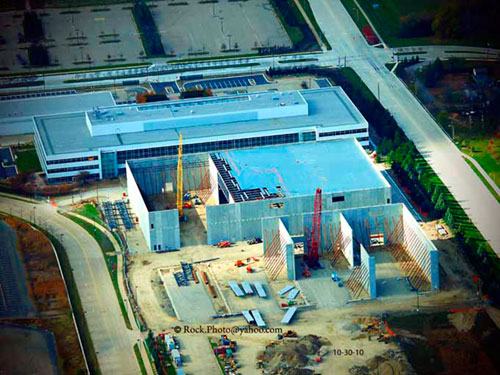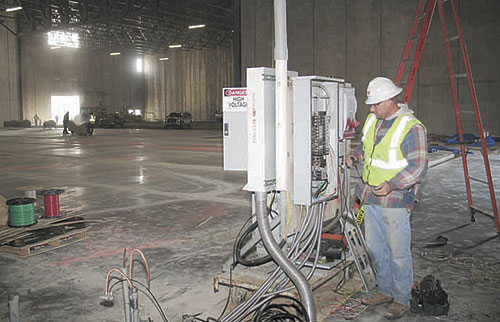Annnd…action. Soundstage construction comes to Michigan
Date Posted: November 26 2010
PONTIAC – When it comes to moving the state forward into the business of making motion pictures, television and video production, they’re not messing around at Raleigh Michigan Studios.
Under the leadership of design-builder Walbridge and their subcontractors, the building trades are transforming 427,000 square-feet of space in the former General Motors Truck Products Center East office building for the use of studio tenants and film education. But the feature attraction is the erection of a massive and versatile soundstage complex adjacent to the office building.
Said Walbridge Project Supt. Garry McIver: “I’ve lead tours too numerous to count through here, and the first response is always, ‘wow.’”
‘Wow’ is about right. The trades are erecting shelled-out buildings from the ground up that will have everything a modern motion picture-making crew needs. “It’s not just the structure, but what the space is capable of,” Walbridge Project Manager Mark Corey said.
The script of building features would impress any director:
*Adequate electrical infrastructure to run all the lighting and provide all the power a studio production could need. The complex has more primary electrical capacity than Royal Oak Beaumont Hospital.
*Walls are comprised of 371 massive pre-cast concrete panels manufactured in Grand Rapids and trucked to the site under special load permits. The walls are 15 inches thick, 62 feet-tall and weigh from 65,000-80,000 lbs.
*The overhead trusses are tremendous – more than 70 tons each. “The load capacity of the steel is enormous,” McIver said. To illustrate, he said a typical parking deck is built at a rating of 40 lbs. per square-foot. The steel supporting the soundstages’ roof will also be able to support a load of 5,000 lbs. per-point. Moviemakers can suspend cars or even a helicopter from the ceiling.
*The interior walls of the soundstages will be wrapped with two-inch-thick batts of Insulquit, a brand-name sound insulation.
*“Elephant doors” that measure 17 feet tall by 22 feet wide, allow ingress and egress of huge pieces of scenery and equipment to the soundstages. They apparently have the name because in the early years of Hollywood studios, the doors were so heavy that pachyderms were used to open and close them.
*There are nine soundstages, with seven in new structures adjacent to the East office building. Three of the stages will be 30,000 square-feet, two will be 20,000 square-feet, and two will be 12,000 square feet. By moving some walls, it’s possible to create a single stage of 90,000 square-feet.
“Size-wise, this studio will rival anything in Hollywood and really, any in the world,” Corey said.
The renovation and re-use of the existing East building is one bit of good news in a state that could use it. Only 15 years old, the Centerpoint campus was humming just a few years ago with the presence of thousands of GM engineers and other staffers. With GM’s near-fatal financial troubles in recent years, the campus has emptied and had weeds growing tall in the parking lots. Los Angeles-based Raleigh Studios was approached by local partners who saw potential in the facility and decided it would be a great place for a film studio. Like other studios, it was spurred by the generous tax credit given by the State of Michigan to attract filmmakers.
The Raleigh Michigan Studios formally broke ground on July 27, although construction had been going on for some time. About 90 Hardhats are currently on the project and more than 150 will be employed at peak. The entire complex is scheduled to be handed over to the studio in the Spring of 2011.
“The trades have been fantastic,” McIver said. “It’s been a tough schedule, and we’ve met and beat every milestone. The trades have helped us work through every issue so far, so that we can meet the schedule.”
Raleigh said its goal is to employ 3,500 Michigan residents at the studio. The making of Raleigh Michigan Studios has been underway since early 2008, with the most daunting task arranging some $60 million to $80 million in financing.
Heading up the project is shopping mall magnate A. Alfred Taubman, along with Walbridge Chairman and CEO John Rakolta, Jr. and Linden Nelson, chairman and CEO of Michigan Motion Picture Studios. The state says at least 96 movies or TV productions have been filmed in the State of Michigan so far, and the Michigan Film Office believes the new sound stages will draw even more television production.
The facility is also going to double as a teaching venue, training people in film industry trades.
“We feel that the addition of Raleigh Michigan Studios to the Centerpoint Business Campus will be a tremendous catalyst for growth,” said Etkin Equities principal James Ketai. “The revitalization (of the former GM Truck Product Center) is a great example of the resurgence that is beginning to take place throughout Michigan – it’s showing the world that Michigan is a great place to do business.”
Nelson told the Oakland Press that the state’s filmmaker tax incentives have so far been an attraction to filmmakers, and now the soundstage will make our state even more of a magnet.
This will be “one of the finest facilities in America,” Nelson said. “We are doing this first rate. That is one of the things we made a decision on from day one.”

THIS IS AN AERIAL VIEW of the Raleigh Michigan Studios from late last month. The new studio-soundstages are in the foreground. In the background is the former GM Truck Products Center East building – formerly offices for GM engineers – which will be transformed into studio offices and film educational facilities.

WORKING IN THE CAVERNOUS Stage “D” at Raleigh Michigan Studios is Chris Orfin of IBEW Local 58, working for Maryland Electric. He’s installing the wiring for a 120/240v. panel.
